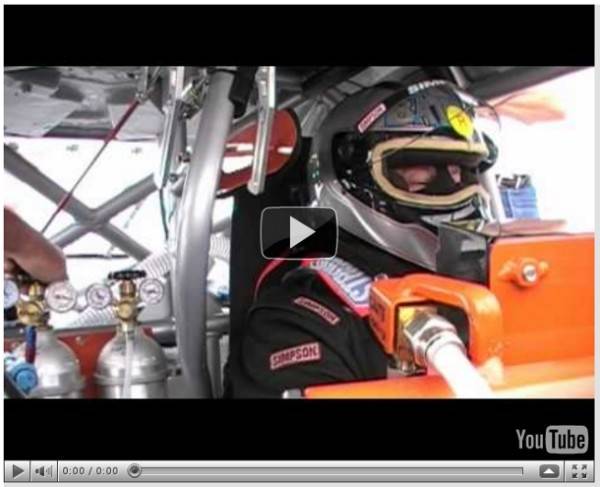Can you imagine a better way to promote your racing engine business than to take your Web site visitors, on a mind-bending video demo ride? For the last decade, Tom Nelson of Nelson Racing Engines (NRE), in Chatsworth California, has been building the nastiest, tire shredding, frame-twisting, internal combustion engines, on the planet. They had to get a bigger dynamometer because the old one only went up to 2000 horsepower!
How do I know it’s true? I’ve watched most of his absolutely awesome videos on YouTube.

Rob Reilly is a technology consultant, writer and portable computing expert. Links to many of his published articles appear on his Web site. Contact Rob at [email protected].
Although some of the company’s early videos were a tad bit grainy and decidedly homemade, they showed off the product line in grand style. Have a look at Nelson’s 2007 video of a customer’s 1963 Pontiac Tempest, with a twin-turbo, 522 cubic inch big-block Chevy. The color, contrast, and composition are pretty decent. Compare that to their recent trip to Bonneville showcasing a AAB Gas Coupe Dodge Barracuda. The ‘Cuda engine is one of NRE’s twin-turbo big-block Hemis. . The video is crisp, clear, and high-def. Even if you aren’t a car fanatic, watching these videos certainly gives you an appreciation of the quality of the car, engine, and people.

Nelson uses a video production group now and I think the level of quality and sophistication of the videos mirror that of his engine building. With some of Nelson’s race motors going for $50K to $60K, it’s easy to see why he puts a few bucks into posting premium on-line clips.
On the other hand, developing your own in-house videos, has never been easier. All it takes is a desire to learn the techniques and a modest amount of cash for some decent equipment.
DIY YouTube Business Video
I briefly ventured into do-it-yourself (DIY) business video last year when my brother wanted to promote his law practice. The results were reasonable, considering our lack of experience and approaching zero budget. Coupling a decent camera and softbox lights, with experience doing three or four more videos, would boost the quality of most new DIY videographers, tenfold.
Equipment can be pretty austere. We used a couple of umbrellas on stands with compact florescent (CFL) lights, an off-white background, and a tiny little Flip video recorder on a tripod, in a living room. All in all, we spent most of a morning setting everything up and then running through the takes.
The clip came out pretty well, although there a whole bunch of things I’d do differently next time. For one thing, we’d use a high-definition video camera, perhaps something from Sony or Canon. I noticed that some of the in-car NRE footage was shot with a compact, hand-held camcorder, that anybody can buy. Even then, they looked great. Don’t forget some digital SLR cameras and many high-end smartphones can now record good-quality video and sound.
Another thing I’d do differently would be lighting. If you don’t have adequate lighting, your videos will come out dark, without much contrast. My brother’s video could have used a little more light. A lot of current Web videographers use green screens and then substitute a pure white or graphical background, behind the talent doing the talking.
Video editing software is also readily available for the average-Joe director and runs well on higher-end desktop and notebook computers. I used the Open-Source kdenlive video editing application on a fairly stout Asus Linux powered notebook for our video. Windows users should probably stick with commercial video editors, such as Adobe’s Premier series, Apple’s Final Cut, and Sony’s Vegas programs because large user communities have grown up around these packages. Although not cheap, Adobe’s Creative Suite 5.5 lists for around $1,700, you’ll get a complete, stable package that will produce exceptional results. A modest investment in training, software, and equipment can bring in a lot of business. If you use Linux, high-end Open Source video applications, such as OpenShot, kdenlive, kino, and the Open Movie editor are usually just a download away.
Plan For Your Video Future
Singapore based Adrian Lee, founder of VideoLane.com, thinks video production knowledge will be essential for executives, in tomorrow’s professional job market. His 2011 Forecast For Videography Trends In Business article offers a couple of interesting observations, First, camcorders are now as cheap as printers. Second, if a picture paints a thousand words, one second of video paints thirty thousand words. Why read pages of text when a short video clip says it all.Äù
Lee has been doing corporate videos for over 10 years. Of course, you’d certainly expect a video production company to use videos to promote their own business. Lee goes a step further and has ginned up some video how-to’s. Want to learn how to set up a green-screen? Here’s one of Lee’s tutorials. The clip was nicely done and full of useful information.
He also has a very informative clip titled Promote Your Business With YouTube – Five More Easy Ways you can see here:
That’s A Wrap
Web videos have improved considerably, over the last few years. They used to be poor to moderate-quality personal footage, shot on analog camcorders, by amateurs.
Not any more. Businesses are now getting into the video act…so to speak…in a big way.
High-quality, high-definition videos are all over the place. YouTube lets you post 15-minute videos for free. Serious business people should definitely consider the improved speed and no-advertisement advantages of a paid video hosting site. Take a look at the ReadWriteCloud article How To Choose The Right Host For Your Online Video.
Are creating videos to promote your business worth all the time, effort, and expense?
Feast your eyes on this one promoting the GoPro HD sports camera, then decide. The helmet cam version goes for about $300.
I just might need to go order one and find a few cool new video projects!










